 Leading Blog | Posts by Month |
 Leading Blog | Posts by Month |
10.31.19

LeadershipNow 140: October 2019 Compilation
See more on
Posted by Michael McKinney at 09:05 AM
10.28.19

Beginner’s Pluck: 14 Principles to Build Your Life of Purpose
YOUR PURPOSE is not out there waiting to be found. Your purpose is something you build. Being clueless is where the adventure begins. Liz Forkin Bohannon is the co-founder and CEO of Sseko Designs. Sseko Designs creates opportunity for women and girls living in extreme poverty, but they aren’t another charity. Instead, they employ women in Uganda to make footwear and accessories allowing them to earn money towards college degrees so that they can stop the cycle of poverty for themselves and their families and eventually move into other fields. Sseko Designs the largest exporter of non-agricultural goods from Uganda to the U.S. Bohannon shares her journey in Beginner’s Pluck: Build Your Life of Purpose and Impact Now. It is well worth reading for would-be entrepreneurs, but the insights and lessons apply to any area of life. Her journey is not what you would expect but you will find it encouraging because it is down-to-earth. Bohannon’s wit and personality come through, making it a joy to read. (She has a Masters in Journalism.) We all have been encouraged to “follow our dreams” and to “find our passion.” She says, “what I think was meant to be a message of encouragement and empowerment is actually creating anxiety, fear, and serious analysis paralysis.” The message is a myth. “Stop wasting your time hunting for a unicorn that doesn’t exist and instead get down to the incredibly juicy, adventurous, life-giving work of building an extraordinary life of passion, purpose, and impact.” This is one of the best books you’ll find on the topic. And one worth handing off to anyone starting out in life. She has distilled from her experience, 14 principles to build your life of purpose. I’ll list them below with a comment from the book to give you a taste of the insights you’ll find here. The Principles of Beginner’s Pluck Own Your Average You. Are. Average. 2. Stop Trying to “Find Your Passion” To believe that your passion and purpose exists, fully formed “out there” … and is waiting to be found is a kind of lunacy. And it puts an awful lot of pressure on you to make the right step and get the right degree and open the right door so the stars align and you can, in a cinematically glorious moment Find Your Passion. 3. Dream Small There are lots of excuses that can keep you from pursuing your Big Dream of quitting your job and becoming a full-time artist who can actually pay their bills and then some. So, make it smaller. Go smaller and smaller until you have no more excuses. 4. Chose Curiosity Over Criticism Curiosity is not only one of the greatest tools we have in building lives of purpose and passion, it’s a mindset that each and every one of us can choose, each and every day. 5. Be on Assignment in Your Own Life Show up like a cub reporter, new on the beat. Start looking around and ask interesting questions, not needing to confirm your preexisting biases. 6. Find and Replace What if every time we thought we should be looking for THE solution, we Found and Replaced “Solution” with “Wicked Problem?” 7. Surprise Yourself If you want to build a life of passion and purpose, you’re best off if you’re willing to be surprised by what it looks like. You might actually build a passionate life doing something that in a million years, you’d never have been able to see coming. And you will never know unless you are open enough to try. You’ll never be surprised if you’re running every idea through a 12-point checklist and making sure it aligns perfectly with everything you think you know about your interests and gifts and experience and natural inclinations. 8. Get Your Steps In Think about having a Fitbit for your life. Doesn’t actually matter where you’re going, so much as that you get your steps in. 9. Get Hooked on Making (and Keeping!) Promises Make a promise that aligns not with what you want now, but what you want most in life. Building a life of purpose and impact is not some mystical, cryptic, cosmic code to be cracked, it’s actually just a series of meaningful promises, small and large, that you actually keep. Do. The. Work. 10. Be Good with Good Enough What is the least amount of time/energy/resources I can put into this concept/idea/dream before I can put it out into the universe and actually start getting real-life feedback that will enable me to make it even better? 11. Stop, Drop, and WOW A spirit of WOW must be intentionally cultivated. 12. Dream to Attract Your Team Your dream will attract your team. Asking for help is one of the most vulnerable and courageous things you will ever do. You will face rejection. But I promise you the hurt is worth having a dream that eventually attracts your team. 13. Don’t Hide from The Shadows The degree to which you can experience true joy and lasting fulfillment is equal to the degree to which you hold space for darkness and questions. 14. Walk One Another Home We were all created in the image of The Divine to partake in the beautiful and terrifying dance of giving and receiving, joy and disappointment, miracles and mistakes. We don’t need you to be anyone else’s hero. We just need more people walking one another home. 
Posted by Michael McKinney at 11:32 PM
10.25.19

4 Simple Habits for Turning Down the Noise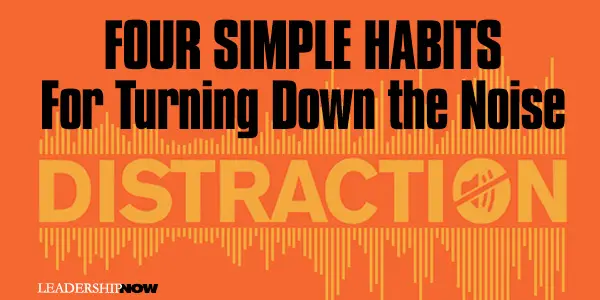
WE ARE ALL DISTRACTED, and we are faced with more and more reasons to be distracted. And while some distractions seem to be adding to our life, they are actually undermining our growth. Distractions take us away from what we should be doing and kills our momentum. But the problem with distractions goes deeper than that. It’s an emotional issue. Clay Scroggins deals with the root problem and the impact it has on our leadership in How to Lead in a World of Distraction and offers some solid advice. Sometimes we use distractions to distract us from what we don’t like going on inside of us. When something we don’t like screaming inside us, we always find something outside—and external distraction—and turn it up. And it works. That outside noise distracts us for a time. In mutes the inner turmoil, the uncomfortable emotions, the pain, the inadequacy, the discomfort, the memories. It hides whatever we don’t want to feel or experience. We allow our emotions to control our lives instead of taking control of them, and it puts a lid on our growth. “If we think the answer to our emotions is to cancel class, run to social media, or use masking tools to avoid what’s inside, it’s no wonder we’re getting the results we’re seeing.” As leaders, we need to be aware of the distractions that affect us and deal with what is going on inside of us. “A leader that doesn’t know themselves is a dangerous guide.” Scroggins offers four noise-canceling habits that will allow you to turn down the noise low enough and long enough to tune into the emotions going on inside you. “The only way to combat the old habit of distraction,” says Scroggins, “is to develop new habits to create space for emotional curiosity.” 1. Simplicity Know your why. “Find that one sentence that defines why you do the things you do, and it can have massive repercussions on your life moving forward. When you clarify your why—and by that, I mean the answer to every ‘why do you do what you do’ question—you can start to live and lead effectively.” He suggests we ask four questions of ourselves: What are the things I no longer need? What can I afford to get rid of? What are the things keeping me from what matters most? And how can I organize my life so that I know exactly what I’m looking for and I can easily see what matters right away? Your why becomes the filter through which you can decide what you spend your time on. 2. Speaking to Yourself Yeah. That voice inside our heads. That voice that tells us who we are and what choices we should make. The point is, it’s our voice so we can control what it says. Distractions, like social media, create insecurities. And that insecurity takes us in all kinds of unhealthy directions. “That’s how the voice inside your head works. It snowballs the negative things you hear and say throughout your day in powerful ways. But here’s the good news: the reverse is true as well.” The antidote is reminding ourselves of “specific truths that counter the lies perpetuated by our negative self-talk.” We have to regulate what goes in our heads. “Self-talk is the means through which you regulate what’s going in and out of your brain. It’s the way you control the narration, so the voice speaking to you adds value and makes you better.” He adds, “filter out the noises that aren’t adding value.” Your self-talk should be about the kind of person—the kind of leader—you want to be. Scroggins offers two good questions: “What would a great leader do here?” and “What advice would I give someone else who was in this situation?” They give you some objectivity in your particular situation. 3. Silence It is important to get away to a quiet place. It can be anywhere you can find some solitude. “Solitude means being alone with yourself long enough to learn who you are.” 4. Pressing Pause You have to plan for a time-out. Create a “sabbath” your life. Taking a fast from social media is a good way to slow down and create some space in your life. But not just social media. “What keeps you from finding rest?” “When you turn down the noise, you give yourself the gift of evaluation.” It also helps you find your rhythm. It helps you to re-center your life and realign with your why. You can step back from all of the noise and see the bigger picture. One of his most important and insightful chapters is the last chapter, Master Control. Growing as a leader means taking control—mastering control. And specifically, what is going on inside of us. To begin, there are two questions we should think about: What are you going to allow to control you? Positive emotions release dopamine and serotonin, and we keep coming back for more, and they can take control. So far, so good. But negative emotions will produce the same effect, and so we keep them around as well, returning to them again and again. In their own way, they also make us feel better. “Negative emotions can be intoxicating. And as with an addictive substance, the more you take the bait on them, the more your tolerance of them grows. And the more your tolerance grows, the more you create the patterns that keep you coming back for more.” Scroggins observes: The busier my life gets, the louder the nose. The louder the noise, the cloudier my future feels. The less clarity I feel about my future, the more I’m tempted to take the bait on negative emotions. Clarity doesn’t equal certainty, but it is vital to your leadership. “You can lead others better when you feel like you know where you’re going in your own life.” So, raise the volume of your influence by turning down the noise. 
Posted by Michael McKinney at 04:58 PM
10.23.19

Becoming Interdependent as A Team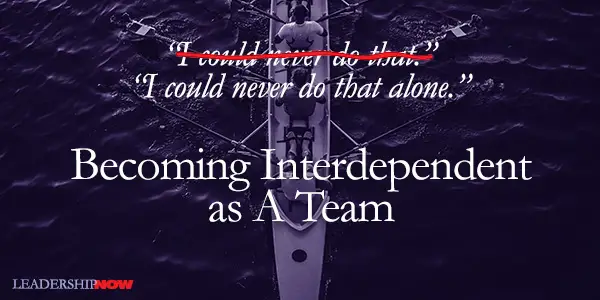
THIRTY-FIVE DAYS, 14 hours, and 3 minutes. That’s how long it took Jason Caldwell and the crew of the American Spirit to row 3,000 miles across the Atlantic Ocean during the 2016 Talisker Whiskey Atlantic Challenge. They not only succeeded but set a world record. Success like this is a result of the teams you build and how you choose to lead them. Jason Caldwell calls it Emotion-First Leadership. In Navigating the Impossible, Caldwell takes us through his journey to becoming an elite-rower to explain how he learned to build teams and lead them to perform in challenging conditions. Quit Like A Winner His journey began by quitting. He quit baseball after an injury and went to the boathouse to qualify to row eights. The important thing is to quit like a winner. “Quitting is nothing more than weighing two variables and finding that one of them has stopped being worth it.” What is your threshold for suffering and sacrifice for the goal you have set before you? Failure isn’t quitting—it’s never finding out what you should be doing. Your path to success often begins the day you realize what your focus should be. The path to doing difficult things is not mindless enthusiasm. It is to learn about yourself. Learning about yourself is the only way to block out negativity, endure past adversity, and meet the goal you’ve set. Building A High-Performance Team High-performance team members are interdependent. That interdependency is achieved by leveraging a single emotion—trust. As a leader, do you have the team member’s best interests at heart? You can’t fake it. The best way to be authentic and built this type of trust on your team is to worry less about the alignment of your strategies and more about the alignment of your own emotions. Do you care about your people? Are you more concerned about who they are becoming, or do you care only about what they are capable of producing for your bottom line? Do you pull hard for them before asking them to pull hard for you? Leveraging the emotions of your team is about asking each person “what they want to be, and then you create for them the opportunity to be what they want.” This is not static. People change, and their motivations change, and you need to “need to make it your mission to become obsesses with those evolutions.” Gathering Points Emotional connections are built over time through hundreds of individual connections—interactions. You can’t pull an all-nighter to make this happen. You can’t cram for it. Instead, you need to take advantage of gathering points. In rowing, “gathering points are the places in the stroke where you are expected to check your alignment to make sure it’s in line with that of the team.” If not, you reset and realign. (Alignment: When rowing, “I wasn’t trying to copy him. I was anticipating.”) Caldwell said the emotional connection didn’t happen in the boat or in the gym, “it happened at the bar or at dinner or late at night in the boathouse.” As a high-performance team leader, you need create as many of these gathering points as possible. You need gathering points that your team can’t get enough of. Gathering points that the team craves are the result of a team that knows why they are doing what they are doing and have set before them a challenging goal that they genuinely want to be a part of. “If your environment is mundane, it means you are not asking enough of the team you lead. If there is no challenge, who cares about checking in with one another.” Caldwell offered this litmus test of a team that I found meaningful: “If losing a member of your team is no big deal, then you don’t have a team at all.” The best teams are always personal. Human emotions are the cornerstones of high performance, and leveraging them requires building connections through consistently looking for and hitting gathering points. Navigating the Impossible is full of insightful lessons about team building pulled from the experiences of rowing to eventually winning the 2016 Talisker Whiskey Atlantic Challenge. The annual race that begins in early December is indeed the world’s toughest row. The death-defying challenge of it all and the emotion of the race is captured well in Caldwell’s retelling of the adventure. It’s not just about hitting that sales number or winning that race. It’s about you and your teammates discovering together what can happen when emotional human beings connect and commit to a goal. Once you see that, you’ll be changed. 
Posted by Michael McKinney at 05:28 PM
10.14.19

Robert Iger's 20 Leadership Lessons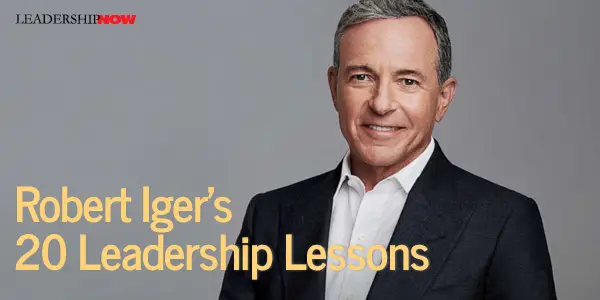
ROBERT IGER has worked for the same company for forty-five years: twenty-two of them at ABC, and another twenty-three at Disney, after Disney acquired ABC in 1995—the last fourteen of those years, as the CEO of Disney. He shares it all in The Ride of a Lifetime. Like the biggest, most exciting rides were once called at Disneyland, he says his time as CEO of Disney has been like a fourteen-year ride on a giant E-Ticket attraction. After sharing a bit of his background, he quickly delves into his career beginning at ABC, and the lessons he’s learned and the principles that have guided him that help “nurture the good and manage the bad.” He explains the thinking behind his habit of waking at 4:15 am. It’s vital to create space in each day to let your thoughts wander beyond your immediate job responsibilities, to turn things over in your mind in a less pressured, more creative way than is possible once the daily triage kicks in. I am certain I’d be less productive and less creative in my work if I didn’t also spend those first hours away from the emails and text messages and phone calls that require so much attention as the day goes on. Iger writes of the key mentors in his career and his relationship with Steve Jobs, George Lucas, and Michael Eisner. Iger truly embraces innovation. When he took over as CEO in 2005, he laid out three strategic priorities saying it should be about the future, not the past: Recommit to the concept that quality matters, embrace technology instead of fighting it, and think bigger—think global—and turn Disney into a stronger brand in international markets. These priorities have guided the company through all of the growth and acquisitions since he was named CEO. Today, Disney is the largest media company in the world, counting Pixar, Marvel, Lucasfilm, and 21st Century Fox among its properties. Its value is nearly five times what it was when Iger took over. You have to approach your work and life with a sense of genuine humility. The success I’ve enjoyed has been due in part to my own efforts, but it’s also been due to so much beyond me, the effort and support and examples of so many people, and to twists of fate beyond my control. What follows are 20 leadership lessons from the book but stripped of the stories that brought them to life. You’ll have to read the book to get that. 1
2
3
4
5
6
7
8
9
10
11
12
13
14
15
16
17
18
19
20

Posted by Michael McKinney at 10:39 AM
10.09.19

What Every Business Leader Needs to Know to Thrive in an Economic Downturn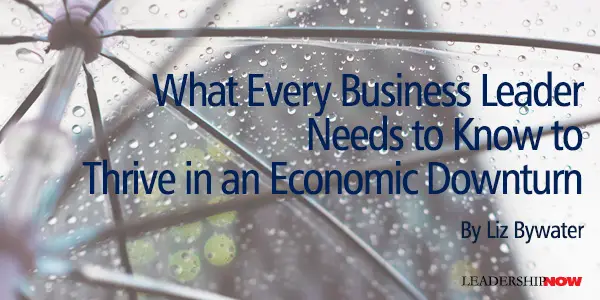
A convergence of troubling signs forecast a looming economic downturn. Many believe it’s certain that a recession is pending. Proactive business leaders aren’t worried. They see any economic change as a springboard for profitable growth and competitive advantage. Rather than spreading a message of caution, worry or gloom, they’re sending a more strategic message: “We will not decline when the economy falters. We will instead show the market what we’re made of.” The strategic leader knows the importance of stepping out of the busyness of business despite the temptation to go faster in times of economic uncertainty. But speeding up only adds pressure and overwhelms the workforce. Stretching employees to the limit by having them put in longer hours, sell more, and get faster results only leads to burnout and neglects the longer view. By attending to the here-and-now and neglecting the longer view or bigger picture, organizational leaders and their teams may do well enough for a while. But they’re unlikely to thrive over time. True success lies in knowing when to slow down and when to speed up. Building in a strategic pause, or deliberate break in the day -- or week or month -- allows leaders to stop doing and start thinking. It allows time for developing a high-impact plan of action with clear accountabilities, timelines, and pathways of communication. They can then come away with a renewed sense of confidence, purpose, and optimism. To recession-proof their businesses, companies should be slowing down and allowing time to identify ways to be proactive, strategic, and future-focused. Use strategic pauses to assess these six factors that can lead to accelerated growth and a recession-proof business: 1. Assess the competition. Make time to understand in which ways the competition has the advantage. What are your competitors’ gaps or weaknesses? How can you differentiate and elevate your organization to gain advantage and increase market share? 2. Assess your organization. Determine where you are today as a team and a company. What do you bring? What are your signature strengths and talents? Do you have the right people in the right roles, doing the right things to ensure success today and accelerate growth and innovation for a stellar future? And, importantly, are you adding value in ways that mean the most to you, the company, the customer, and your clients? 3. Assess the market. What will differentiate your organization as a future-focused, customer-centric, innovation-driving engine of growth? Where will you see profitable openings in the market? Ask yourself: Will less agile organizations struggle to keep up? How will we pick up customers in need of access to the products and services we offer? Which new products and services can we provide to fill the void? 4. Assess risk. Where might you lose market share in the face of an economic downturn? Which employees are likely to become worried about the future of the company or industry? What’s your plan for retaining and developing your top talent? 5. Look out over the horizon. While it’s essential to continue providing exceptional customer service, product reliability, and your tried-and-true client offerings, you must also be laser-focused on driving meaningful innovation that improves all your product lines and service offerings. 6. Assure your stakeholders. Make sure that your employees, customers, and investors see you and your company as confident, courageous, savvy, and ready to make the most of any economic shifts that come along. Slowing down and pausing can feel implausible and impractical in the midst of an economic free-fall. But by taking the time to develop a more thoughtful path forward, you will be ensuring your success in any economic climate. 
Posted by Michael McKinney at 01:40 AM
10.07.19

Stephen Schwarzman’s 25 Rules for Work & Life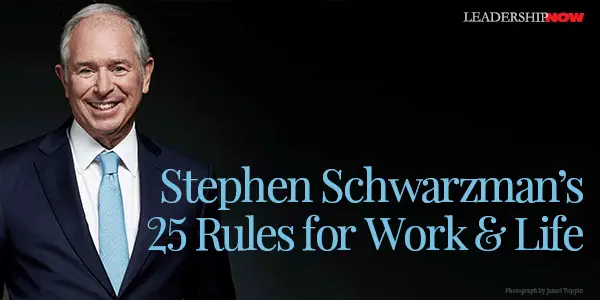
BLACKSTONE chairman, CEO, and co-founder Stephen Schwarzman has written a book about the potential that can be realized when you combine personal responsibility with ambition. What It Takes: Lessons in the Pursuit of Excellence chronicles his life leading up to the founding of Blackstone and the journey to build it into what it has become today. He shares the lessons and the opportunities that have come his way as a result of his success. It is inspiring and instructive. Well worth the time to read. Schwarzman grew up in a successful entrepreneurial family selling curtains and linens in Philadelphia. His Dad was content with the one store. Schwarzman was not. He had more ambition. Even in high school he wanted to create something more than the status quo. Through connections and hard work, he got a popular rhythm and blues group of the late 50s, Little Anthony and the Imperials, to come and play at his school. He learned that “if you want something badly enough, you can find a way. You can create it out of nothing. But wanting something isn’t enough. If you’re going to pursue difficult goals, you’re inevitably going to fall short sometimes. It’s one of the costs of ambition.” But you try anyway. With good grades and being fleet-of-foot, he was admitted to Yale University. Like most freshmen, he was lonely and intimidated. He got through it and during the summer he grew in confidence by taking a job at sea. With a new mindset he began his sophomore year determined to make it create something out of nothing as he did in high school. He started a dorm room business and a dance society to bring girls around. His determination and creativity make for a good read. After graduation he got a job at Donaldson Lufkin Jenrette, went to Harvard Business School and ended up at Lehman. This is where he really learned about finance and discovered his strengths. He left Lehman and in 1985 Schwarzman co-founded Blackstone with his mentor and friend Pete Peterson with a $400,000 investment. Today, Blackstone has over $500 billion in assets under management. But as with all new ventures it had its share of inflection points, setbacks and disappointments. He says, “To be successful you have to put yourself in situations and places you have no right being in. You shake your head at your stupidity. But through sheer will, you wear the world down, and it gives you what you want.” Here are 25 more rules for work and life that are woven throughout his book: 1
2
3
4
5
6
7
8
9
10
11
12
13
14
15
16
17
18
19
20
21
22
23
24
25

Posted by Michael McKinney at 07:51 AM
10.03.19

7 Steps to Bulletproof Problem Solving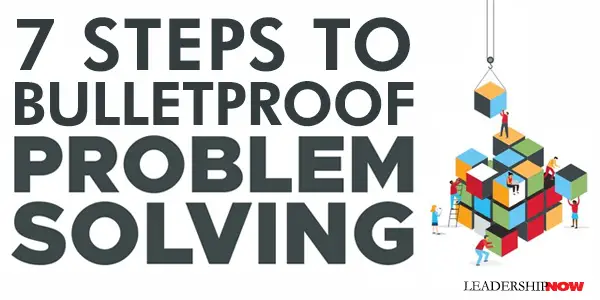
THE WORLD ECONOMIC FORUM’S Future of Jobs Report lists complex problem-solving as the number one skill for jobs in 2020. Organizations are looking for people that can define problems and form solid creative responses. Like leaders themselves, good problem solvers are made, not born. Yet these skills are rarely taught. That’s where Bulletproof Problem Solving comes in. McKinsey alums Charles Conn and Rob McLean teach us how to be bulletproof problem solvers using a simple 7-steps approach. The approach has its foundation in the hypothesis-driven structure of the scientific method. This process is not just applicable to business but is useful in finding solutions for personal problems as well. In the book they apply the process to individual problems such as, “Should I put solar panels on my roof?,” “What career should I choose?,” and “Is where I live affecting my health?” Business examples range from “Should my startup raise its prices?” and “Should we go to court?” to “Can obesity be reduced?” This process can be applied to nearly every problem is responds well to the systematic problem-solving method that this approach provides. The Seven Steps to Bullet-Proof Problem Solving are: Step One: Define the Problem
Step Two: Disaggregate the Issues
Step Three: Prioritize the Issues, Prune the Tree
Step Four: Build a Workplan and Timetable
Step Five: Conduct Critical Analyses
Step Six: Synthesize Findings from the Analysis
Step Seven: Prepare a Powerful Communication
While this is presented in a linear way, the authors make a great point that you learn more about the problem as you go. You shouldn’t be so eager to get to the end that you don’t go back and refine previous steps. “While the process has a beginning and an end, we encourage you to think of problem solving as an iterative process rather than a linear one. At each stage we improve our understanding of the problem and use those greater insights to refine our earlier answers.”

Posted by Michael McKinney at 04:30 AM
10.01.19

First Look: Leadership Books for October 2019Here's a look at some of the best leadership books to be released in October 2019. Don't miss out on other great new and future releases.
Do you know how to play the game you’re in?
In Sailing True North, Admiral Stavridis offers a much more intimate, human accounting: the lessons of leadership and character contained in the lives and careers of history's most significant naval commanders. He brings a lifetime of reflection to bear on the subjects of his study—on naval history, on the vocation of the admiral with its special tests and challenges, and on the sweep of global geopolitics. Above all, this is a book that will help you navigate your own life's voyage: the voyage of leadership of course, but more important, the voyage of character. Sadly, evil men can be effective leaders sailing toward bad ends; ultimately, leadership without character is like a ship underway without a rudder. Sailing True North helps us find the right course to chart.
How can you be the leader you want to be, every day? The answer is more than a time-management system or a silver-bullet solution for changing your routines. Leadership expert and coach Amy Jen Su's powerful new book helps readers discover that the answer lies within. By focusing in specific ways on five key leadership elements—Purpose, Process, People, Presence, and Peace--you can increase your time, capacity, energy, and ultimately your impact, with less stress and more equanimity.
In The Intelligent Leader, Mattone lays out an accessible, practical, and compelling path that anyone can take to become the kind of leader that brings enrichment to the lives of others, enjoys a more fulfilling life, and leaves a lasting legacy. Each chapter uses a variety of real-world examples, tools, and assessments to explore one of Mattone’s 7 dimensions of Intelligent Leadership.
In this three-part book, Gino Wickman reveals the six essential traits that every entrepreneur needs in order to succeed, based on real-world startups that have reached incredible heights. If these traits ring true for you, you’ll get a glimpse of what your life would look like as an entrepreneur. What’s more, Wickman will help you determine what type of business best suits your unique skill set and provide a detailed roadmap, with tools, tips, and exercises, that will accelerate your path to startup success.
What You Do Is Who You Are is a journey through culture, from ancient to modern. Along the way, it answers a question fundamental to any organization: who are we? How do people talk about us when we’re not around? How do we treat our customers? Are we there for people in a pinch? Can we be trusted? Who you are is not the values you list on the wall. It’s not what you say in company-wide meeting. It’s not your marketing campaign. It’s not even what you believe. Who you are is what you do. This book aims to help you do the things you need to become the kind of leader you want to be—and others want to follow.
 Build your leadership library with these specials on over 39 titles. All titles are at least 40% off the list price and are available only in limited quantities. “It is a man’s duty to have books. A library is not a luxury, but one of the necessities of life.” — Henry Ward Beecher
Posted by Michael McKinney at 12:20 AM
|
BUILD YOUR KNOWLEDGE


How to Do Your Start-Up Right STRAIGHT TALK FOR START-UPS 
Grow Your Leadership Skills NEW AND UPCOMING LEADERSHIP BOOKS 
Leadership Minute BITE-SIZE CONCEPTS YOU CAN CHEW ON 
Classic Leadership Books BOOKS TO READ BEFORE YOU LEAD |
|